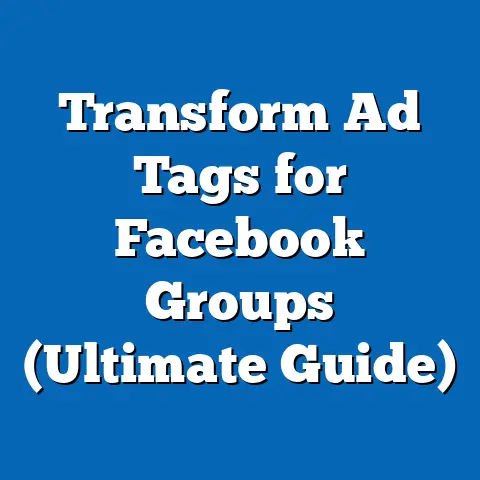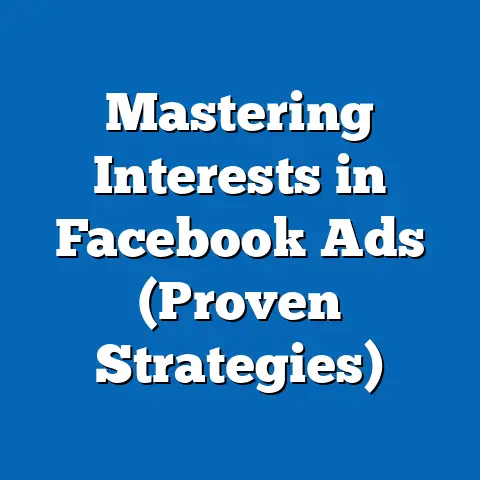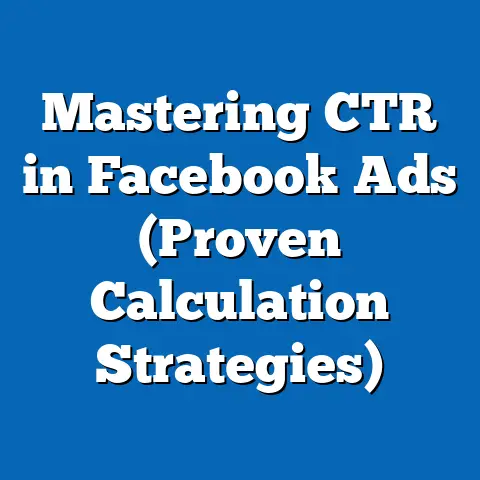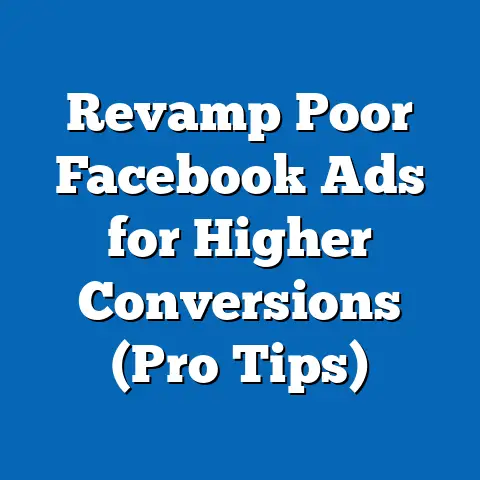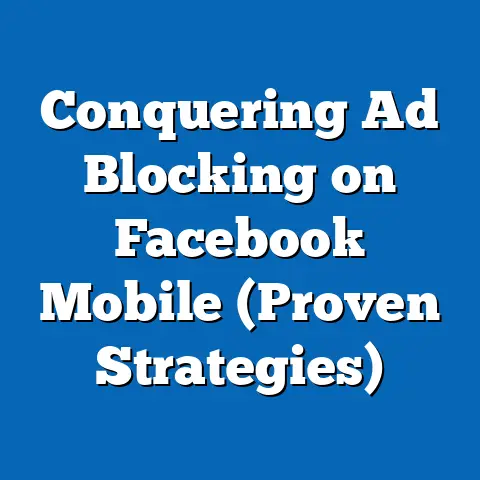Generate Leads Effortlessly with Facebook Ads (Pro Tips)
In today’s world, where sustainability is not just a trend but a necessity, businesses are increasingly looking for ways to integrate eco-friendly practices into their marketing strategies. I’ve seen firsthand how digital marketing, particularly through platforms like Facebook, can be a powerful tool for aligning business goals with environmental values. Unlike traditional paper-based marketing, which contributes to deforestation and waste, online advertising offers a more sustainable approach by minimizing environmental impact.
Facebook Ads, with their vast reach and precise targeting capabilities, provide an exceptional opportunity to generate leads effectively while staying true to eco-conscious principles. In this article, I’ll share pro tips that will help you create and optimize your Facebook Ads campaigns to not only drive business success but also contribute to a healthier planet. Let’s dive in!
Understanding Facebook Ads
Facebook Ads are a powerful tool for businesses looking to reach a broad audience and generate leads. They are paid messages that businesses use to promote their products, services, or brand on Facebook. Unlike organic posts, which are only seen by your existing followers, Facebook Ads can be targeted to specific demographics, interests, and behaviors, allowing you to reach potential customers who are most likely to be interested in what you have to offer.
The Power of Facebook Ads: Statistics and Reach
According to recent data, Facebook has nearly 3 billion monthly active users, making it one of the most popular social media platforms in the world. This massive reach, combined with Facebook’s sophisticated targeting capabilities, makes it an invaluable tool for lead generation. In fact, businesses often report that Facebook Ads are a key driver of their online lead generation efforts. I’ve personally witnessed numerous campaigns where Facebook Ads significantly outperformed other marketing channels in terms of cost per lead and overall ROI.
Types of Facebook Ads for Lead Generation
Facebook offers a variety of ad formats to suit different marketing goals and creative styles. Here are some of the most effective ad types for lead generation:
-
Carousel Ads: These ads allow you to showcase multiple images or videos in a single ad unit, each with its own headline, description, and link. Carousel ads are great for highlighting different products, features, or benefits.
-
Video Ads: Video ads are highly engaging and can be used to tell a compelling story about your brand or product. Short, attention-grabbing videos are particularly effective for lead generation.
-
Image Ads: Simple yet effective, image ads can be used to showcase a single product or offer. Make sure your image is visually appealing and relevant to your target audience.
-
Slideshow Ads: Similar to video ads, slideshow ads combine multiple images with text and music to create a dynamic visual experience. They are a cost-effective alternative to video ads.
-
Lead Ads: These ads are specifically designed for lead generation. They include a built-in form that allows users to submit their contact information without leaving Facebook. This makes the lead generation process quick and easy.
Carousel Ads: These ads allow you to showcase multiple images or videos in a single ad unit, each with its own headline, description, and link. Carousel ads are great for highlighting different products, features, or benefits.
Video Ads: Video ads are highly engaging and can be used to tell a compelling story about your brand or product. Short, attention-grabbing videos are particularly effective for lead generation.
Image Ads: Simple yet effective, image ads can be used to showcase a single product or offer. Make sure your image is visually appealing and relevant to your target audience.
Slideshow Ads: Similar to video ads, slideshow ads combine multiple images with text and music to create a dynamic visual experience. They are a cost-effective alternative to video ads.
Lead Ads: These ads are specifically designed for lead generation. They include a built-in form that allows users to submit their contact information without leaving Facebook. This makes the lead generation process quick and easy.
Leveraging Facebook’s Audience Targeting Features
One of the biggest advantages of Facebook Ads is the ability to target your ads to specific audiences based on demographics, interests, and behaviors. This allows you to reach the people who are most likely to be interested in your product or service. For example, if you’re selling eco-friendly cleaning products, you can target your ads to people who have expressed an interest in environmental conservation, sustainable living, or organic products.
Takeaway: Facebook Ads offer a powerful and versatile platform for lead generation. By understanding the different ad types and leveraging Facebook’s audience targeting features, you can create highly effective campaigns that reach your ideal customers.
Crafting Compelling Ads
Creating high-converting Facebook Ads requires a combination of captivating visuals, persuasive copy, and a strong call to action. The goal is to grab the attention of your target audience and entice them to take the desired action, whether it’s visiting your website, filling out a lead form, or making a purchase.
Elements of a High-Converting Facebook Ad
-
Captivating Visuals: Use high-quality images or videos that are visually appealing and relevant to your target audience. Your visuals should immediately grab attention and convey the key message of your ad.
-
Persuasive Copy: Write clear, concise, and compelling ad copy that highlights the benefits of your product or service. Focus on how your product can solve a problem or fulfill a need for your target audience.
-
Strong Call to Action: Include a clear and compelling call to action that tells users what you want them to do. Use action-oriented language such as “Learn More,” “Sign Up Now,” or “Get Started Today.”
Captivating Visuals: Use high-quality images or videos that are visually appealing and relevant to your target audience. Your visuals should immediately grab attention and convey the key message of your ad.
Persuasive Copy: Write clear, concise, and compelling ad copy that highlights the benefits of your product or service. Focus on how your product can solve a problem or fulfill a need for your target audience.
Strong Call to Action: Include a clear and compelling call to action that tells users what you want them to do. Use action-oriented language such as “Learn More,” “Sign Up Now,” or “Get Started Today.”
Creating Eco-Friendly-Themed Ad Content
If you’re targeting environmentally conscious consumers, it’s important to create ad content that resonates with their values. Here are some tips for creating eco-friendly-themed ad content:
-
Highlight Sustainability: Emphasize the eco-friendly aspects of your product or service. Talk about the materials used, the manufacturing process, or the environmental benefits of using your product.
-
Use Green Imagery: Incorporate images and videos that evoke a sense of nature, sustainability, and environmental responsibility. Think lush forests, clean oceans, and renewable energy sources.
-
Tell a Story: Share stories about how your company is making a positive impact on the environment. This could include initiatives such as reducing waste, conserving energy, or supporting environmental organizations.
-
Promote Eco-Friendly Offers: Offer discounts or incentives to customers who choose eco-friendly options. This could include offering a discount for using reusable packaging or donating a portion of the proceeds to an environmental charity.
Highlight Sustainability: Emphasize the eco-friendly aspects of your product or service. Talk about the materials used, the manufacturing process, or the environmental benefits of using your product.
Use Green Imagery: Incorporate images and videos that evoke a sense of nature, sustainability, and environmental responsibility. Think lush forests, clean oceans, and renewable energy sources.
Tell a Story: Share stories about how your company is making a positive impact on the environment. This could include initiatives such as reducing waste, conserving energy, or supporting environmental organizations.
Promote Eco-Friendly Offers: Offer discounts or incentives to customers who choose eco-friendly options. This could include offering a discount for using reusable packaging or donating a portion of the proceeds to an environmental charity.
Examples of Successful Eco-Friendly Ads
I’ve seen several successful campaigns that effectively combine sustainability with lead generation. One example is a company that sells organic cotton clothing. Their Facebook Ads feature images of models wearing their clothing in natural settings, along with copy that highlights the sustainable materials used and the ethical manufacturing practices employed. The ads also include a clear call to action, such as “Shop Now” or “Learn More About Our Sustainability Initiatives.”
Another example is a company that offers solar panel installation services. Their Facebook Ads feature videos of satisfied customers talking about the environmental and financial benefits of switching to solar energy. The ads also include a lead form that allows users to request a free consultation.
The Importance of A/B Testing
A/B testing is the process of comparing two versions of an ad to see which one performs better. This is an essential part of optimizing your Facebook Ads campaigns for lead generation. You can A/B test different ad components such as images, headlines, copy, and calls to action. By testing different variations, you can identify the elements that resonate most with your target audience and improve the overall performance of your ads.
Takeaway: Crafting compelling Facebook Ads requires a combination of captivating visuals, persuasive copy, and a strong call to action. By creating eco-friendly-themed ad content and A/B testing different ad components, you can create highly effective campaigns that generate leads while staying true to your environmental values.
Targeting Your Audience
Effective audience targeting is crucial for the success of your Facebook Ads campaigns. By targeting your ads to the right people, you can increase your chances of generating high-quality leads and achieving a positive ROI. Facebook offers a variety of targeting options to help you reach your ideal customers.
Facebook’s Targeting Options
-
Demographics: Target your ads based on age, gender, education, location, and other demographic factors.
-
Interests: Target your ads based on people’s interests, hobbies, and passions.
-
Behaviors: Target your ads based on people’s online behavior, such as their purchasing habits, device usage, and travel preferences.
-
Custom Audiences: Create custom audiences based on your existing customer data, such as email lists, website visitors, or app users.
-
Lookalike Audiences: Create lookalike audiences based on your existing customer data. Facebook will identify people who share similar characteristics and behaviors with your existing customers.
Demographics: Target your ads based on age, gender, education, location, and other demographic factors.
Interests: Target your ads based on people’s interests, hobbies, and passions.
Behaviors: Target your ads based on people’s online behavior, such as their purchasing habits, device usage, and travel preferences.
Custom Audiences: Create custom audiences based on your existing customer data, such as email lists, website visitors, or app users.
Lookalike Audiences: Create lookalike audiences based on your existing customer data. Facebook will identify people who share similar characteristics and behaviors with your existing customers.
Segmenting Audiences Based on Eco-Friendly Interests
To effectively target environmentally conscious consumers, you need to segment your audiences based on their eco-friendly interests and behaviors. Here are some examples of eco-friendly interests you can target:
- Environmental Conservation
- Sustainable Living
- Organic Products
- Renewable Energy
- Veganism
- Zero Waste
You can also target people who have engaged with eco-friendly content on Facebook, such as liking environmental organizations, joining sustainability groups, or sharing articles about climate change.
Refining Targeting for Improved Lead Quality
To improve the quality of your leads, it’s important to refine your targeting based on the performance of your ads. Monitor your ad performance metrics, such as click-through rates, conversion rates, and cost per lead, to identify which audiences are most responsive to your ads. You can then narrow your targeting to focus on those audiences.
Creating Effective Audience Personas
An audience persona is a fictional representation of your ideal customer. Creating audience personas can help you better understand your target audience and tailor your ads to their specific needs and interests. When creating audience personas, consider the following factors:
- Demographics: Age, gender, location, education, income
- Interests: Hobbies, passions, values
- Behaviors: Online habits, purchasing preferences
- Pain Points: Challenges, frustrations, needs
By creating detailed audience personas, you can develop more effective ad copy, visuals, and targeting strategies.
Takeaway: Effective audience targeting is essential for generating high-quality leads with Facebook Ads. By segmenting your audiences based on eco-friendly interests and behaviors, refining your targeting based on ad performance, and creating detailed audience personas, you can reach the right people with the right message.
Optimizing Your Campaigns
Monitoring and analyzing ad performance is crucial for optimizing your Facebook Ads campaigns and maximizing your ROI. By tracking key performance indicators (KPIs) and making data-driven adjustments, you can improve the effectiveness of your ads and generate more leads at a lower cost.
Monitoring and Analyzing Ad Performance
Facebook Ads Manager provides a wealth of data about the performance of your ads. Here are some of the key metrics you should be tracking:
- Impressions: The number of times your ad was shown.
- Reach: The number of unique people who saw your ad.
- Click-Through Rate (CTR): The percentage of people who clicked on your ad after seeing it.
- Conversion Rate: The percentage of people who completed a desired action (e.g., filling out a lead form, making a purchase) after clicking on your ad.
- Cost Per Click (CPC): The average cost you pay each time someone clicks on your ad.
- Cost Per Lead (CPL): The average cost you pay for each lead generated by your ad.
- Return on Ad Spend (ROAS): The amount of revenue you generate for every dollar you spend on ads.
Adjusting Ad Spend Based on Performance Data
Based on your ad performance data, you can adjust your ad spend to focus on the campaigns and audiences that are generating the best results. For example, if you find that one audience is generating leads at a lower cost than another, you can allocate more of your budget to that audience.
The Significance of Retargeting Ads
Retargeting ads are ads that are shown to people who have previously interacted with your business, such as visiting your website, watching a video, or filling out a lead form. Retargeting ads are highly effective because they target people who are already familiar with your brand and have shown an interest in your products or services.
Timing and Frequency of Ads
The timing and frequency of your ads can also impact their performance. Experiment with different ad schedules to see when your target audience is most responsive. You can also use frequency capping to limit the number of times a person sees your ad. This can help prevent ad fatigue and improve the overall effectiveness of your campaigns.
Takeaway: Optimizing your Facebook Ads campaigns requires continuous monitoring and analysis of ad performance data. By adjusting your ad spend, retargeting ads, and optimizing the timing and frequency of your ads, you can improve the effectiveness of your campaigns and generate more leads at a lower cost.
Leveraging Facebook’s Ecosystem
Facebook offers a variety of features that can be integrated with your Facebook Ads campaigns to enhance your lead generation efforts. By leveraging these features, you can create a more seamless and engaging experience for your target audience.
Integrating Facebook Ads with Facebook Lead Ads
Facebook Lead Ads are specifically designed for lead generation. They include a built-in form that allows users to submit their contact information without leaving Facebook. This makes the lead generation process quick and easy, which can significantly improve your conversion rates.
Using Facebook Messenger for Lead Generation
Facebook Messenger can be used to engage with potential leads and answer their questions in real-time. You can use Messenger bots to automate the lead generation process and provide personalized responses to common questions.
Creating Engaging Content for Facebook Groups
Facebook Groups are a great way to build a community around your brand and engage with potential leads. Create engaging content that is relevant to your target audience and encourages them to join your group. You can then use your group to share exclusive offers, answer questions, and build relationships with potential customers.
The Role of User-Generated Content and Testimonials
User-generated content and testimonials can be highly effective in building trust and credibility with potential leads. Encourage your customers to share their experiences with your product or service on Facebook. You can then use this content in your ads to showcase the benefits of your product or service.
Takeaway: By integrating Facebook Ads with other Facebook features, such as Facebook Lead Ads, Messenger, and Facebook Groups, you can create a more seamless and engaging experience for your target audience and enhance your lead generation efforts.
Conclusion
Generating leads with Facebook Ads can be both effective and sustainable. By aligning your marketing strategies with eco-friendly values, you can not only drive business success but also contribute to a healthier planet. I encourage you to take action by implementing the tips shared in this article. Remember, every small step towards sustainability can make a big difference. Let’s work together to create a more sustainable future for our businesses and our planet.

